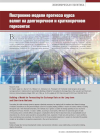Building a Model for Forecasting the Exchange Rate on the Long-term and Short-term Horizons
DOI: https://doi.org/10.33917/es-6.186.2022.16-25
Forecasting the ruble exchange dynamics appears objectively necessary for shaping both the medium-term financial strategy of industry corporations and the general strategic course for occupying leading positions in sectors of business interest, including through the use of new financial instruments, new markets and, in general, a system of strategic planning of socio-economic development of Russia. However, in today’s realities, according to most experts, with whom we cannot but agree, the task of forecasting seems extremely difficult and appears complicated by the fact that the launched crises are unpredictable and are characterized by a diverse nature (pandemic and geopolitical crises, expansion of trade wars and sanctions). In such conditions, when uncertainty grows excessively, it is important to turn to the accumulated experience: to analyze to what extent the available models can be suitable for prospective assessments in the current environment.
References:
1. Kuranov G.O. Metodicheskie voprosy kratkosrochnoi otsenki i prognoza makroekonomicheskikh pokazatelei [Methodological Issues of Short-Term Assessment and Forecast of Macroeconomic Indicators]. Voprosy statistiki, 2018, no 25(2), pp. 3–24.
2. Frenkel’ A.A., Volkova N.N., Surkov A.A., Romanyuk E.I. Sravnitel’nyi analiz modifitsirovannykh metodov Greindzhera — Ramanatkhana i Beitsa — Greindzhera dlya postroeniya ob”edinennogo prognoza dinamiki ekonomicheskikh pokazatelei [Comparative Analysis of Modified Granger-Ramanathan and Bates-Granger Methods for Developing a Combined Forecast of Economic Indicators Dynamics]. Voprosy statistiki, 2019, no 26(8), pp. 14–27.
3. Shirov A.A. Makrostrukturnyi analiz i prognozirovanie v sovremennykh usloviyakh razvitiya ekonomiki [Macrostructural Analysis and Forecasting under Current Conditions of Economic Development]. Problemy prognozirovaniya, 2022, no 5, pp. 43–57.
4. Dmitrieva M.V., Suetin S.N. Modelirovanie dinamiki ravnovesnykh valyutnykh kursov [Simulating the Dynamics of Equilibrium Exchange Rates]. Vestnik KIGIT, 2012, no 12–2(30), pp. 061–064.
5. Linkevich E.F. Mirovaya valyutnaya sistema: poliinstrumental’nyi standart [World Monetary System: Polyinstrumental Standard]. Krasnodar, 2014, pp. 82–91.
6. Ageev A.I., Loginov E.L. Izmenenie strategii operirovaniya dollarom: zapusk SShA novogo kreditno-investitsionnogo tsikla vo vzaimosvyazi s valyutnymi voinami [Changing the Strategy of Dollar Handling: US Launch of New Credit-Investment Cycle in Association with the Currency Wars]. Ekonomicheskie strategii, 2015, no 3(129), pp. 20–35.
7. Fedorova E.A., Lazarev M.P. Vliyanie tseny na neft’ na finansovyi rynok Rossii v krizisnyi period [Impact of Oil Prices on the Financial Market of Russia During the Crisis]. Finansy i kredit, 2014, № 20(596), pp. 14–22.
8. Kuz’min A.Yu. Valyutnye kursy: v poiskakh strategicheskogo ravnovesiya [Exchange Rates: in Search of Strategic Equilibrium]. Ekonomicheskie strategii, 2018, no 1, pp. 82–91.
9. Prakticheskoe posobie po sezonnoi korrektirovke programmnym obespecheniem JDemetra+. EEK OON. Zheneva, 2020 g. [A Practical Guide to Seasonal Updating with JDemetra+ Software. UNECE. Geneva, 2020]. EEK OON, available at: https://unece.org/sites/default/files/2021-01/2008647_R_ECE_CES_STAT_2020_3_WEB.pdf.
10. Kondrat’ev N.D. Bol’shie tsikly kon”yunktury [Big Cycles of Conjuncture]. Voprosy kon”yunktury, 1925, no 1, pp. 28–79.
11. Kondrat’ev N.D., Yakovets Yu.V., Abalkin L.I. Bol’shie tsikly kon”yunktury i teoriya predvideniya. Izbrannye trudy [Big Cycles of Conjuncture and the Foresight Theory. Selected Works]. Moscow, Ekonomika, 2002, 767 p.
12. Glaz’ev S.Yu. Otkrytie zakonomernosti smeny tekhnologicheskikh ukladov v TsEMI AN CCCR [Discovering the Pattern of Changing Technological Structures at CEMI, Academy of Sciences of the USSR]. Ekonomika i matematicheskie metody, 2018, no 54(3), pp. 17–30, DOI: 10.31857/S042473880000655-9.
13. Glaz’ev S.Yu. Sovremennaya teoriya dlinnykh voln v razvitii ekonomiki [Modern Theory of Long Waves in Economic Development]. Sait S.Yu. Glaz’eva, available at: https://glazev.ru/articles/6-jekonomika/54548-sovremennaja-teorija-dlinnykh-voln-v-razvitii-jekonomiki.
14. Glaz’ev S.Yu. O formirovanii ideologii perekhoda k novomu mirokhozyaistvennomu ukladu v Rossii i EAES [On Forming the Ideology of Transition to a New World Economic Order in Russia and the EAEU]. Ekonomicheskie strategii, 2020, no 7(173), pp. 46–61, DOI: https://doi.org/10.33917/es-7.173.2020.46-61.
15. Pereslegin S.B. VI tekhnologicheskii uklad: prostranstvo vozmozhnostei [Technological Order VI: the Space of Opportunities]. Ekonomicheskie strategii, 2019, no 3(161), pp. 24–33, DOI: https://doi.org/10.33917/es-3.161.2019.24-33.



